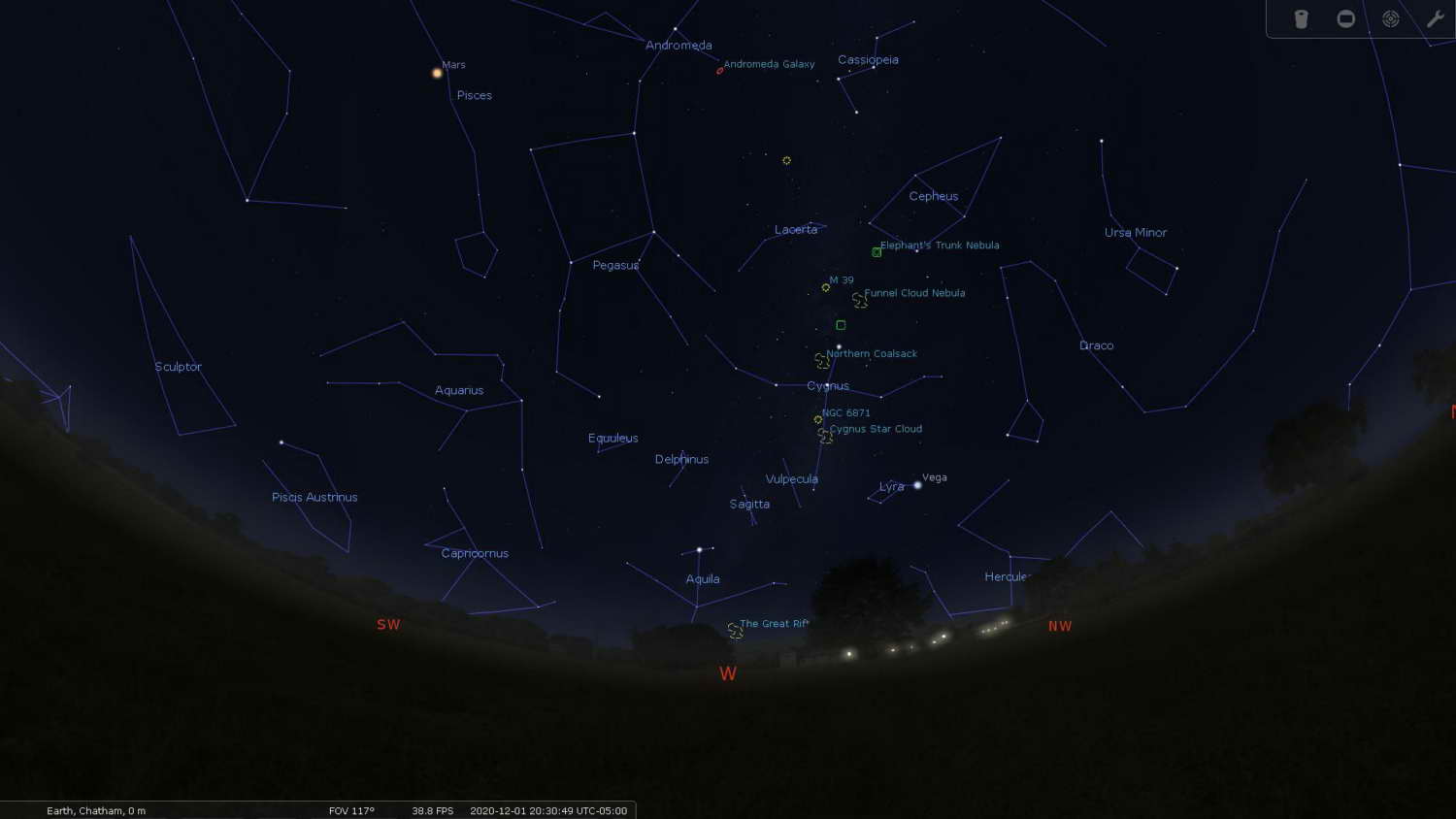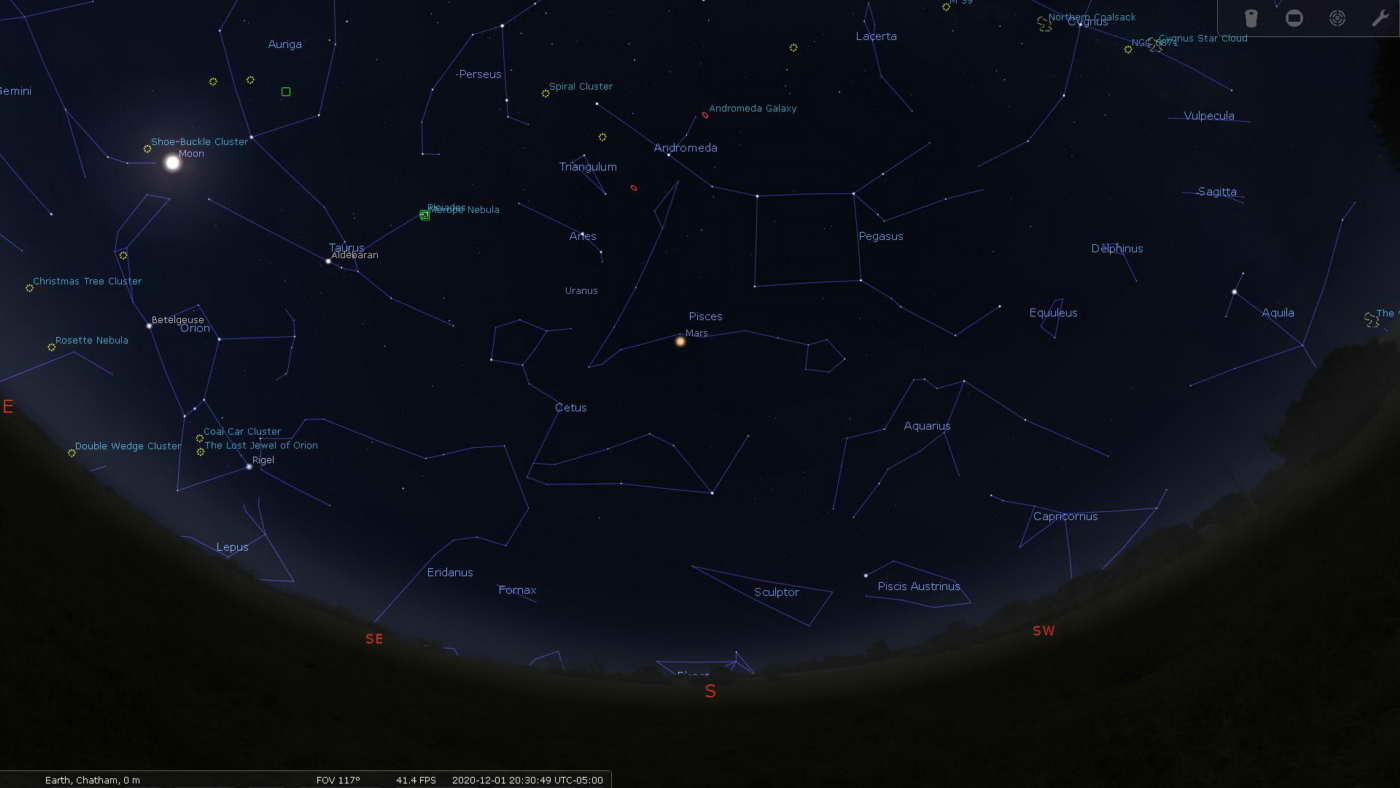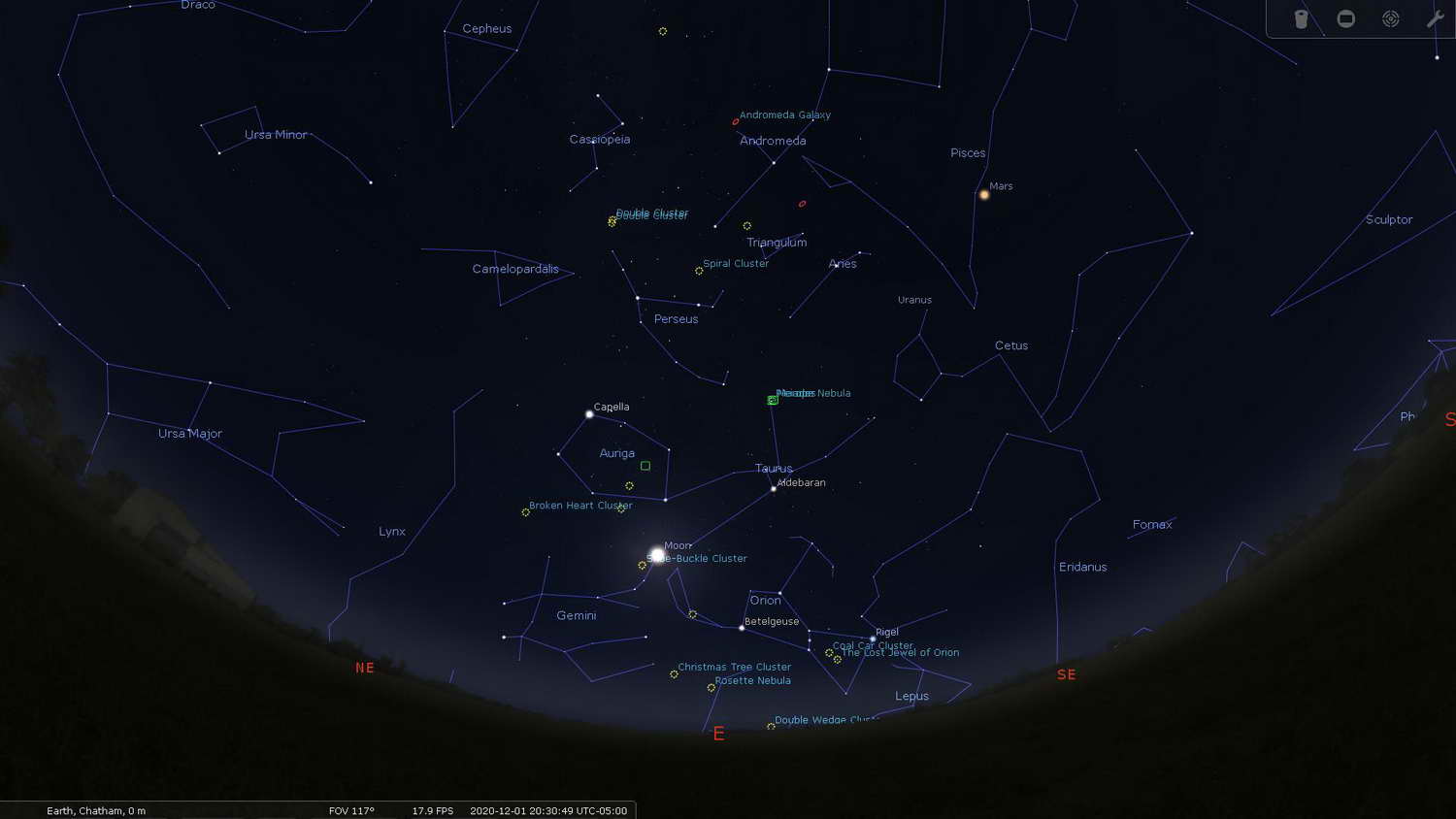The December Night Sky and Your First Telescope?
This month’s look at the sky is going to take a slightly different tack than before. We have spent the past months focusing on the major bright planets. However, December brings us the benefit of dark skies that come early, along with some fantastic deep sky objects. Oh, and there is a pretty cool meteor shower, too. On top of all that, this is also the month where many people explore the idea of purchasing a telescope. We have lots to cover!
Let’s start with the telescope, first. This is a product where the maxim “you get what you pay for” tends to ring true. Backyard Astronomy is a hobby, and like any hobby, you can be just as casual or serious as you want to be. For those just starting out, it’s tempting to pick up an inexpensive 2-inch refractor scope as their starter scope. If you are not sure whether you or maybe your kids or grandkids are going to stick with it, perhaps spending big bucks isn’t a great idea. Get in cheap and see if they like it first. This line of thinking makes total sense.
Except that when it comes to telescopes, “entry-level” often means frustration. Who wants to start off a new hobby knowing that it probably won’t be fun? This usually guarantees that the hobby won’t be followed. Simply put, the manufacturer isn’t building a quality product at low price points. They are feeding off the ignorance of the consumer who is easily led astray by claims of super-high magnification combined with a low price point. The thinking that most people have is that planets are small, so being able to make them big sounds like a good thing. Unfortunately, It isn’t that simple, but cheap telescope manufacturers are betting you don’t know that.
One of the most popular entry-level telescopes is the 2-Inch refractor. These are smaller, long tube telescopes with a refracting lens on the business end that focuses the light down to a focuser at the looking end. There is nothing inherently wrong with this design, and for years was the leading style of telescope through the 1900s. There is even a working example of a 40-inch refractor at Yerkes Observatory.
The problem starts with the mounts that are provided with cheaper refractors. Mounts can be either Alt-Azimuth (which really means, left/right/up/down) or they can be equatorial mounts, which need to be aligned with the North Pole and they tend to move in arcs that mimic the movement of the sky. The Alt-Azimuth is simple, easy to set up but its capabilities are limited to point and view.
Most cheaper telescopes come with a poorly built version of this type of mount. Once you locate your object in the eyepiece and let go of the scope, it moves, usually down just a bit. This “slop” is frustrating, particularly when you have spent a lot of time trying to find something, and then you can’t keep it in the field of view because you can’t find the sweet spot where the scope will just naturally rest. This is a hobby killer.
Equatorial mounts can have the same issues, as some manufacturers have caught on that offering the more advanced mount will give their product a bit more credibility. Equatorial mounts can have slop, too. Read the reviews! The type of mount you decide on is a purely personal preference. If you aren’t sure you will get much farther than bringing it out to the back yard or the cottage just to look at what’s up there, stick with the Alt-Azimuth mount. If you think there is a good chance you will want to get into astrophotography or long observing sessions, then look into an equatorial mount. Either way, spend time finding out if the mount on the scope you are considering is built well.
The second problem that people run into with telescopes is being able to see stuff! We are constantly bombarded by amazing images from the Hubble Telescope and other research programs. Even advanced amateurs with the right equipment and software can produce images that rival professional observatories. You need to know that what you see in the scope will not look like the pictures.
First of all, you will not see colour, except for planets and certain stars. Most objects look like fuzzy gray clouds while stars look like pinpoints of light. With practice, you will begin to see dark dust lanes and pick up nuances in star colour, but, overall, you will not see colour. There simply is not enough light for the colour receptors in your eyes to detect it.
The size of the telescope matters, too. Larger scopes will bring in more light, allowing you to chase fainter objects (which is where you need a good mount, or forget it!). However, larger scopes are heavier, bulkier, and more expensive. So take some time to figure out what you want to do.
You are not going to be out looking at the stars. Stars through any telescope that you can use in your backyard are going to look very similar to what you see with the naked eye. Some will show colors, some have partners (double stars), but in reality, once you have looked at a few stars, you won’t be spending your nights going from star to star.
The moon and planets are always interesting because they show details. They are also bright. Using an 8-inch telescope to look at the moon is nearly blinding. A 2-inch scope is about perfect. Same for looking at the planets for the most part.
Where things get tricky is in how magnification works. There is only a certain amount of light being gathered to reach your eye. The bigger the scope aperture, the more light gathered and the brighter objects will be. Once you start to magnify them, they get dimmer. Low magnification is like more concentrated light, and higher magnification is more spread out light. The image is bigger but dimmer. If you are looking at deep-sky objects, super high magnification doesn’t work well, as it makes the object too dim, along with the fact that many of these types of objects are actually pretty big. Lower magnification, like around 100x or less is generally where you will spend your time.
Planets, though, are bright. You can really jump the magnification on them, right? Nope. They do provide enough light to use a lot of magnification, but the bright light also gets scrambled up by the Earth’s atmosphere which is constantly in motion. Seeing Jupiter at 500x usually sucks compared to what it looks like at 120x, because you are also magnifying every unsteady air current that blows by between you and the planet! In all my years of observing, I have only had a couple of nights where we could go over 300x on a planet and get a steady view. They were rare nights, with nearly perfectly still, heavy, and hazy skies in late summer. They are not the norm. Don’t be swayed by claims of high magnification.
Truthfully, there are a lot of other things to consider, too. How good is the focuser? How good are the eyepieces? How good are the optics? It is a lot to wade through. I have found, however, that if you find a product with a good mount, the manufacturer also tends to build the rest of the scope to a reasonable degree of quality.
My suggestion is that you figure out what you think you want to do with a telescope, first. Most likely, you are going to start by checking out the moon, planets, some of the brighter deep-sky objects, and a few stars. You don’t need to spend a lot to do that but plan on spending enough to get a good scope. This will allow you to build a foundation and figure out if you want to go further.
Don’t run out and get the big fancy compact Schmidt-Cassegrain with all the computerized bells and whistles until you figure that’s the sort of amateur astronomy you want to do. Keep it quality, and keep it simple. Avoid buying entry-level equipment from the big-box stores. Do a little research, shop your local hobby stores, and check to see if your town has a local astronomy club with members who might be willing to give you tips. You might even find some really good used equipment that way. Online will allow you to compare telescope packages as well, but you will be on your own if you go that route.
My recommendation for people just starting out is to look into a Celestron or Meade system, somewhere between 2 and 6 inches. Those tend to be reliable name brands. You probably want a decent equatorial mount, but there is nothing wrong with an Alt-Azimuth to start with, either. If you are going to stick to planets and the moon, a refractor is just fine and those tend to come in sizes 4 inches and under.
For me, deep sky objects aren’t fun to look for until I am using a scope 8-Inches in size or larger. At that point, you start running into problems moving the thing around, though, and things like the moon are going to be really bright.
I started out on a cheap and frustrating 2-inch refractor but I kept with it. I also had access to amazing telescopes through an astronomy club I joined in high school. As my scope became frustrating, I had quality equipment to use and people to show me things along the way. That made all the difference.
What is There to See in the December Night Sky as 2020 Closes?
Now, on to the December night sky!
Mars is still riding high, although the distance is growing between the Red Planet and Earth. It’s still worth a look through a scope, and it dominates the southern skies through the month, but it is slowly fading. Jupiter and Saturn set very early, but one date to note is December 21. These two planets will be so close together in the dusk sky that they will look like a double planet. The apparent distance between them will be less than the width of a full moon. If you have a telescope, it will be possible to get both of them in the field of view at the same time under low magnification! This is a very rare opportunity.
Venus can be seen in the early morning, low in the east. The month starts with the Moon just slightly past full with the New Moon on December 14. We end the month with a Full Moon on December 30.
We will also be treated to the yearly showing of the Geminid Meteor shower. This shower will peak overnight on December 13-14. It’s not as popular of a Meteor Shower as the Perseids, mostly because it happens in the cold of winter in the Northern Hemisphere. At peak times, this shower can produce 120 meteors per hour, which is quite stunning. It’s worth braving the cold. The Moon will be close to new, which means it will set early in the night. The best time to view this shower is after midnight. Meteors will appear to radiate out from the constellation of Gemini but will appear all over the sky. Put this one on your calendar!
Rising shortly after sunset, M42 or the Orion Nebula begins its appearance in our evening skies. This is a rich star-forming region that is bright enough to see without any sort of optical aid under a dark sky. With a telescope, even a small one, tendrils and wisps of interstellar gas reveal themselves. It is one of the most striking and easy to find objects in our night skies, and a great one to learn to use a new scope on.
Another favorite of mine is the Andromeda Galaxy, located in the constellation of–you guessed it–Andromeda. This one can also be seen in dark skies with the naked eye. Small scopes begin to reveal some of its structure. For my money, though, it should be seen under low power in an 8-inch or larger scope, or it should be seen with binoculars. Even 35×7 binoculars will reveal just how big this galaxy is in our sky. At the start of the month, in the early evening, it’s nearly overhead!
M33, the Triangulum Galaxy is also high up in the sky. Located about a third of the way between the constellation of Triangulum and Andromeda, it’s a fairly bright (as galaxies go) object, but for smaller scopes will pose a challenge. It’s a good object to learn to find by star-hopping and working off of charts. Of course, if you have a fancy scope, just pop the designation in and the scope will do the work!
Star charts for the 2020 December Night Sky
I hope you have enjoyed this little look at what’s up in the December 2020 night sky. Again I would encourage any comments, questions, or topics for the future. Hopefully with some of the major holidays approaching you will find the time to get out under the stars on a clear, crisp, cold night and take the opportunity to view the vastness and complexity of our little corner of the universe. Until next month, happy viewing!
Starmaps courtesy of Stellarium for PC
Published on November 25, 2020 / Information provided based on approximately 40 degrees north Lattitude around 8:30 at night









0 Comments